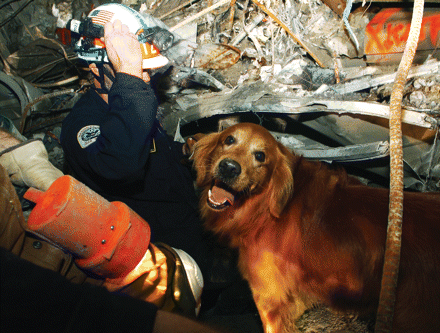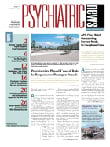For many Americans, the memory of September 11, 2001, is a vividly visual one. When we think of that day, and the days that followed, we see in our minds the images associated with the events and their aftermath. As rescue and cleanup efforts began after 9/11, some of the most iconic images coming from the disaster sites were of the canine search-and-rescue (SAR) teams that participated: Labrador retrievers and German shepherds, border collies and golden retrievers, climbing over and through the mountains of rubble with their human counterparts, calmly and dutifully seeking signs of the victims.
An estimated 250 to 300 SAR dogs and their handlers were involved in recovery efforts at the World Trade Center (WTC), the Pentagon, and at the Fresh Kills Landfill on Staten Island, where 2 million tons of material obtained from ground zero was taken beginning on September 12, 2001, to be sorted and searched for human remains.
The Federal Emergency Management Agency (FEMA) deployed 80 dogs as members of 20 certified urban SAR teams to support the rescue operation in New York. Five other FEMA teams responded to the Pentagon site. Police dogs and other organized SAR teams made up the remainder of the canine participants.
When dogs began to arrive at the sites, animal experts and dog lovers asked the same question: What were the effects of that experience on the dogs and on the people who loved, trained, and accompanied them during those difficult days?
"There are no prior studies to evaluate the potential long-term medical or behavioral effects of SAR activity in dogs after such large-scale urban disasters," wrote Cynthia Otto, D.V.M., Ph.D., a specialist in veterinary emergency and critical care and an associate professor of critical care at the University of Pennsylvania School of Veterinary Medicine, and her colleagues in a 2004 report in the Journal of the American Veterinary Medical Association.
Otto is a member of Pennsylvania Task Force 1 (PA-TF1), a FEMA-mandated urban search-and-rescue team. She deployed along with the SAR dog handlers of PA-TF1 to ground zero for nine days, experiencing firsthand the risks that both humans and animals faced during the recovery effort. Otto and her colleagues continued to monitor the health and behavior of the "9/11 dogs" for years after the events, creating a study cohort of 96 dogs—61 deployed to the WTC site, 23 to the Pentagon, and 12 to Fresh Kills— and a control group of 54 dogs that were not deployed but had similar backgrounds and training.
One complication of evaluating the 9/11 dogs was lack of any previous event from which to draw parallels. "The major long-term consequences of disaster response in humans are psychological and physical sequelae. There are no prior reports of either in SAR dogs," they said. Before 9/11, the bombing of a federal building in Oklahoma City was the only occasion for similar use of dogs for SAR efforts.
There were no predeployment physical or behavioral evaluations of the SAR dogs, and the behavioral surveys Otto and colleagues used to evaluate the dogs' behavior after 9/11 were not designed for or tested in this unique population: "Although validated for companion dogs and designed to be completed by anyone reasonably familiar with a dog's typical behavior, the behavioral survey has not been validated specifically for SAR dogs. Temperament traits considered advantageous in SAR dogs, such as high energy and high drive, are not necessarily the same as those deemed suitable for either companionship or other working roles," they said in the 2004 report.
Injury and illness, including cuts, punctures, lacerations, and abrasions, fatigue, dehydration, heat exhaustion, weight loss, and orthopedic or back problems occurred in most of the 9/11 dogs and affected several organ systems, but all were minor. Only one dog required sutures, for a laceration of a rear foot, the only surgical procedure reported. By the end of the first year after their deployment, there was no evidence that the cohort developed adverse effects related to their work, either medical or behavioral.
The investigators have yet to publish final results of their assessment of the 9/11 dogs because 15 of them are still alive; the median age of the dogs on 9/11 was 5, with an age range of 1 to 11. "We have a couple of projects evaluating the behavioral data, but so far there hasn't been much in the way of association with deployment," Otto told Psychiatric News. "There seem to be no detectable behavioral effects on the group to date. We've also monitored the dogs for early retirement, which has been minimal."
But did the human members of the canine SAR teams fare as well in handling the stress of the 9/11 deployment? Melissa Hunt, Ph.D., a clinical psychologist and the associate director of clinical training in the Department of Psychology at the University of Pennsylvania, complemented the work of Otto and colleagues by assessing 82 of the canine handlers deployed to 9/11 sites. The handlers were compared with 32 nondeployed handlers on measures of posttraumatic stress disorder, depression, anxiety, acute stress, and clinical diagnoses. "The 9/11 search mission was unique in that teams had never searched a manmade disaster so large, where the death toll was so high, and where there were so few survivors," said Hunt and colleagues.
Not surprisingly, deployed handlers reported more PTSD and general psychological distress six months after 9/11 than the control group. But the findings also demonstrated that canine SAR handlers are a fairly resilient population, perhaps one with a lesson for other types of rescue workers." Elucidating what factors, if any, contribute to resiliency among canine SAR workers compared with other emergency workers may benefit first responders as a whole," Hunt and colleagues emphasized.

